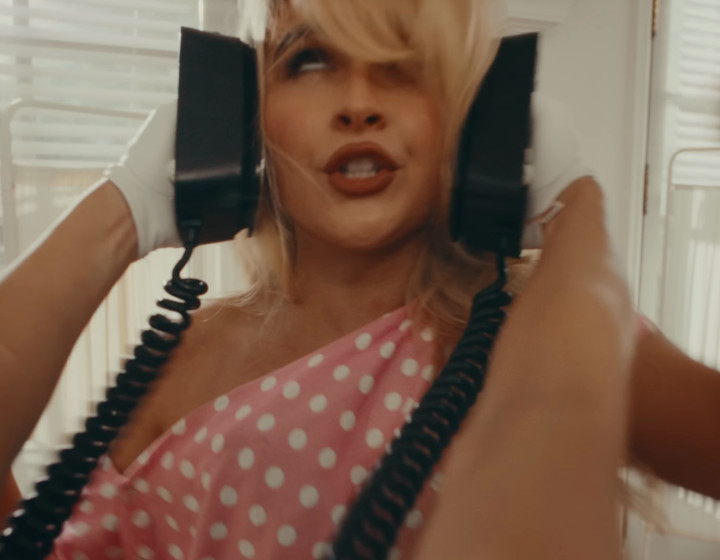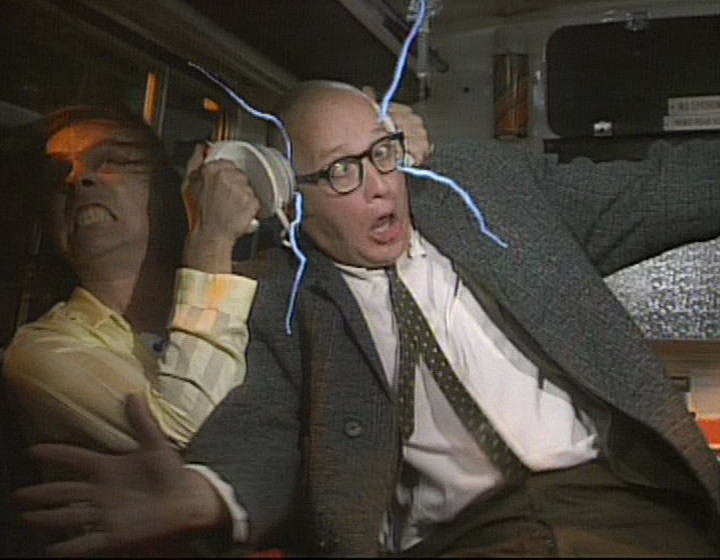Light-Hearted & Fun
One of the great things about library music is the unexpected links it can create across some of my favourite comedy.
For instance, take the Carlin release Light-Hearted & Fun from 1989.1 Every single track on that album was written by Andrew J. Hall. So, there’s the vaguely terrifying “Clowns”:
Which was, of course, used in Alexei Sayle’s Stuff and Monsieur Aubergine, first broadcast on the 3rd October 1991:
The Warners site gives the release date as 1990, but every other source I’ve seen says 1989. ↩
Tangerine Knightmare
Here’s a timely question. What’s the connection between William Friedkin, and Knightmare?
The answer isn’t to be found in anything which was actually broadcast. Because Knightmare had two unbroadcast pilots. One called Dungeon Doom, a 15-minute proof-of-concept recorded in early 1986, and the other, actually called Knightmare, which was a full episode recorded in January 1987.1
And the title music for that second pilot was “Betrayal” by Tangerine Dream: the main theme to Sorcerer, directed by Friedkin in 1977:
The music was also used in the trailer for the film:
It has to be said, what an absolutely wonderful choice of music that was for the Knightmare pilot. I wouldn’t trade Ed Welch’s incredible theme for anything, of course, but “Betrayal” perfectly captures the mood of the series: dark, foreboding, electronic. It could easily have been used as incidental music in the show proper.
But how do we know that second pilot used “Betrayal” for its main theme? Sadly, despite people’s hopes over the years, neither pilot has ever actually leaked online. Which is something that has become increasingly bizarre. The show has a still-active fandom over at Knightmare.com, and next January that site will have been going for 25 years. It’s something which feels like it should have made it out there by now… but hasn’t. Maybe one day. Preferably before I snuff it.
We do, however, have the next best thing. Back in 2010, Billy Hicks got hold of the script of that second pilot, wrote about it, and uploaded the full thing. And as part of that script, we’re told:
Title Music – Tangerine Dream ‘Betrayal’/E Froese, C Frauhe, P Bannman/MCA Records Inc/MCL 1646/Sd2/NV2
The script itself is fascinating, and not just because you can spot the differences between the pilot and Series 1. It’s close enough to the first broadcast episode of Knightmare that it really gives an insight into how the show was put together in those early years. The multiple responses needed by actors must have been absolute agony to learn.
So when you get a moment, give that script a read, and try listening to “Betrayal” in the background. It’s almost as good as actually watching that unbroadcast pilot for real.
Almost.
See Tim Child’s How Knightmare Began for the full story. ↩
As pointed out to me on Twitter, the script manages to misspell both Christopher Franke and Peter Baumann’s last names. ↩
The Docklands, May 1984
Here’s a question for you. What’s the link between Bananarama and Spitting Image?
Clue: the answer is not that Spitting Image did a parody of them. Let’s take a look at this video for “Rough Justice”, released in May 1984, and featuring Peter Woods being very funny:
I’m obviously going to be a sucker for any music video which shows a pop group TAKING OVER TELEVISION. But the immediate question comes to mind – my mind, anyway – is: where exactly was this video shot? Was it in a real television studio? Or did they just set up a recreation on a film stage somewhere?
The Young Ones Music Guide: Series Two
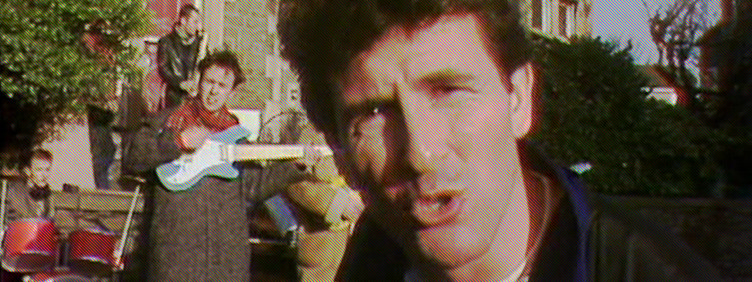
Previously on Dirty Feed, I took an in-depth look at the music used in Series 1 of The Young Ones. This turned out to be a surprisingly popular move. So, how about Series 2?
No preamble, let’s get on with it. Only pop music can save us now…
As before, there are some tracks that I just haven’t been able to identify yet. If you have any ideas, let me know in the comments or elsewhere.
Now He’s Gone
Last year, I wrote about some odd little snippets of The Shangri-Las which had been uploaded to YouTube. They included an unreleased song, rehearsals for “Remember”, studio chatter, and an excerpt of a whole different version of “Leader of the Pack”. As I’m sure you’ll agree, this is one of the most exciting things which has ever happened in the entire history of recorded music.
Recently, I decided to go and listen to it again. And… hang on, what’s all this? Surely the video isn’t shorter? Am I imagining things?
Luckily, I had downloaded the original version of the video at the time. (My spidey-sense was tingling enough on my original listen that I thought that would be a sensible thing to do.) The version of the video I downloaded last year was 3:38 in duration. The version currently on YouTube is 2:35. Hang on, a whole minute missing? I can’t hide the tears, but I don’t care.
So, for those of you who want to hear that minute which mysteriously went missing from the upload, here you go. An alternate take of the start of “Leader of the Pack”, which according to the video description has Betty on lead vocals1:
As for why that minute was silently removed… who knows. The account where this bootleg audio was uploaded is arcane to say the least. For instance, they also uploaded this amazing stereo version of the Shangs magnum opus “Out in the Streets”, which has never been officially released anywhere:
So, a minute of Shangri-Las history: we don’t know where it came from, and we don’t know why it disappeared. But hey, I said last year that the Shangs were “fuelled by myth and mystery”. Even in 2020, mysterious things keep happening. It’s all highly appropriate.
That doesn’t mean we shouldn’t grab an extra minute of fun if we can get it.
Health warning on this claim: a noted Shangri-Las expert who I’ve had the odd email exchange with doesn’t think it actually sounds like Betty. This is precisely the kind of stuff I’m terrible at figuring out, so at this I just throw my hands up and say “Whatever it actually is, it’s interesting, innit?” ↩
The Facts Speak for Themselves, My Friends
Before I knew what library music was, I used to get awfully confused, you know.
There was the time when I was watching Live & Kicking, and music used in Red Dwarf suddenly appeared. Then there was the time when I was at a show in Cadbury World, and, erm, music used in Red Dwarf suddenly appeared. (If you think I have a limited range of reference now, that’s nothing on me at 17.) More amusingly, there was the time when I was listening to Trent FM, and an advert came on… using the music from Central News East a few years previously. (Was that deliberate, to give the ad some already-bought legitimacy in the minds of the audience? Probably not, but it’s fun to ponder.)
These days, I know exactly what library music is, thank you very much, and the world seems a less puzzling place. And recently, a particularly pleasing strand was joined up in my head, as I was clicking around searching for library tracks used in The Young Ones.
That track was “Drama Heights” by John Scott. I first heard it on Spotify, on a 1976 library album called Drama – Tension, but the entire thing is available on Soundcloud for easy embedding::
And it’s a track virtually anybody of a certain age who lived in the UK will recognise, as the main theme for Trev and Simon’s eternally amusing “World of the Strange” sketches:
So, let’s trace things back a little. Where did “Drama Heights” actually come from originally?
The Soundcloud embed above gives a clue as to at least one use: in the film Mark of the Devil Part II, a 1973 German horror/exploitation film that very few people seem to have anything positive to say about. (“Medieval torture and witch-hunting have never been so boring” seems to be the general gist.) The film is so well-loved by its rights owners that, erm, the whole thing has been uploaded to YouTube, and nobody seems to give a damn.
To be honest, the film is exactly the kind of film I don’t want to watch, so I hope you APPRECIATE the fact that I have gone through it, and found the section which uses the track:
Which means that hilariously, we now have a link between German exploitation flicks, and, erm, Fruitang:
Trevor & Simon entered The World of Strange with Fruitang in 1995 pic.twitter.com/tFT8zkdQTw
— UKADS (@ukads3) July 5, 2020
At 29 seconds into that advert, Trevor Neal is this: funny.
So, was “Drama Heights” written for Mark of the Devil Part II? Certainly, the official soundtrack release seems to indicate that it was, without outright stating it:
“John Scott too contributed some music for the score, Scott who is now a seasoned film music composer respected by many, began his career in film scoring as a composer by writing the music for another horror movie A Study in Terror, which was released during the mid 60s. John also had another career as being the legendary sixties producer who recorded several artists like Tom Jones, The Hollies, The Beatles, etc. John is also known for his saxophone work on films like Goldfinger and several Henry Mancini projects. Mr. Scott won 3 Emmys throughout his career.”
You would be forgiven for thinking that John Scott wrote the track specifically for the film, from that paragraph. But “contributed” isn’t the same as “written”, and I was suspicious.
So, the obvious thing is to turn to Discogs. That turns up one very obvious-looking release – the album called Drama – Tension from Conroy in 1976. This is an album which has escaped out into the digital age – indeed, it’s the album I mention above which is on Spotify, which is where this whole little tale started. So, that’s the answer then, yes? That it actually was written for the film, and then became library music a few years afterwards?
No. We can trace it back further. To 1968, in fact – five years before Mark of the Devil Part II. It’s still a Conroy release, and it doesn’t appear to have a name, just a catalogue number. So hello to BMLP 056:
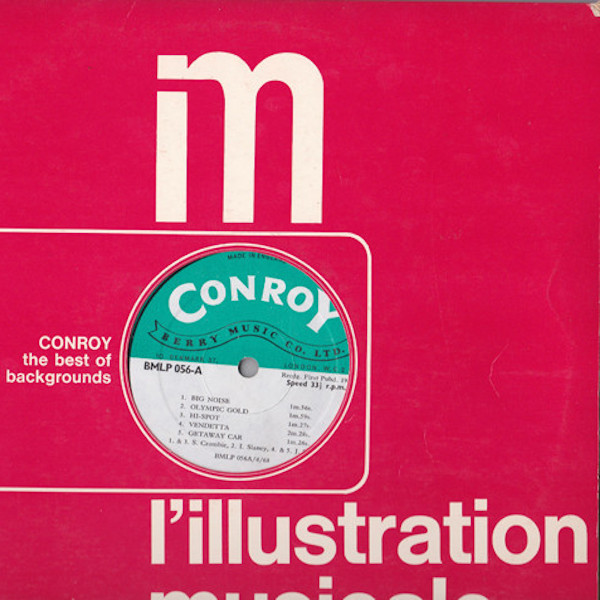
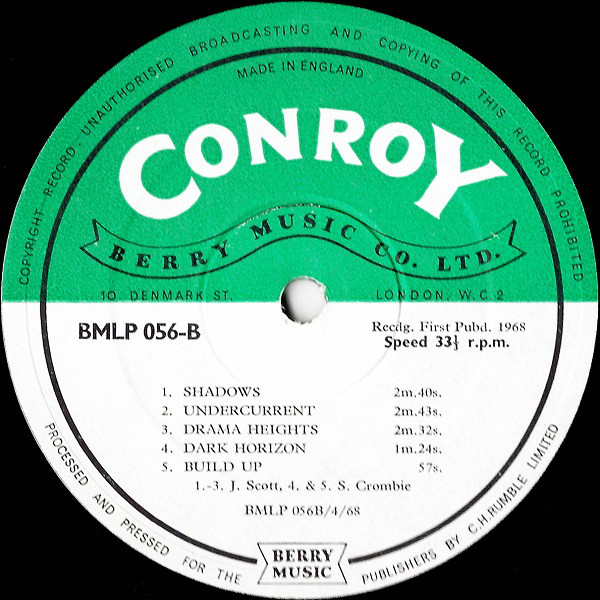
It’s worth noting that “The best of the backgrounds” isn’t the album title – it’s a slogan which was also used on other releases – so we can save ourselves a rabbit hole of thinking this was some kind of Best Of release. As far as I can tell, this was the very first release of “Drama Heights”. Not 1976, not 1973, but 1968.
And who would have guessed in 1968 that the same piece of music would be used in dodgy horror films featuring gratuitous torture scenes, and a Saturday morning kids TV show?
The joy of where library music ends up never seems to fade.
The Dull Religious Music Programme
Back in June, I published the first part of my Young Ones Music Guide, detailing every single piece of music heard in Series 1 of The Young Ones. Some of you may be wondering why the second part is taking so long to appear.
By way of explanation, I have a tale for you today. It is a thrilling tale, tracing a piece of comedy history, full of twists and turns, with a stunning climax. It also features Gregorian chanting and incorrect paperwork, but don’t let that put you off.
Here is how complicated tracing the specific music used in television programmes can be.
The Young Ones Music Guide: Series One

STANDARD YOUNG ONES MUSIC FACT™: Did you know that the reason there’s a band performing in nearly every episode of The Young Ones is so the programme could claim to be a variety show instead of a sitcom, and get a higher budget?
Yes, I did. Right, now that’s out of the way, let’s move on, shall we?
While working on a different project recently, I found myself in need of a complete list of music used in The Young Ones. Sadly, nobody had already written this. After some research, it soon became clear why nobody had already written this.1 Of all the things I’ve done for this site, this has been one of the most difficult and complicated. The Young Ones has a lot of music in it, and a fair amount of it is obscure, sometimes absurdly so.
Not that I was starting entirely from scratch; I do own a copy of the official paperwork listing the music used in each episode. While this was of enormous help, the paperwork is also incomplete, and occasionally incorrect. Luckily, with a combination of that, my own ears, and an army of helpful people on Twitter, I’ve been able to identify the vast majority of the tracks used in the show. This includes chart music, library tracks, and specially written material by Peter Brewis.
There are a still few instances where I’ve unfortunately drawn a blank. These missing tracks are listed like this, along with an audio clip. So if anybody can identify any of these pieces, let me know in the comments, or drop me a line elsewhere. I will love you forever.
Let’s get going. This article covers Series 1; Series 2 will be dealt with separately, because I feel a responsibility not to over-excite you.
No, Wikipedia, a list of band performances in each episode does not count. ↩
Songs in the Key of S
Whenever I watch Look Around You, I’m almost more amazed by the music than anything else.
Don’t get me wrong. The idea that I could write anything like Look Around You is thoroughly ridiculous. But I at least feel I understand it, and a little of how it works. Gelg’s musical talent is magical and mysterious to me. My brain can’t even begin to comprehend it.
Sadly, despite the odd suggestion from Serafinowicz over the years, there has never been a Look Around You album released. (You’d think Warp would have been an obvious home.) But that doesn’t mean that – scattered across the internet – there aren’t ways of hearing lovely, clean, extended versions of some of Gelg’s finest.
So in lieu of that album – which I still hope will happen at some point – let’s see what we can scrape together.

